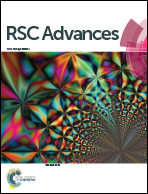Improving poling efficiency by synthesizing a nonlinear optical chromophore containing two asymmetric non-conjugated D–π–A chains†
Abstract
To improve the poling efficiency of nonlinear optical (NLO) chromophores, we have designed and synthesized a chromophore containing two asymmetric donor–π–acceptor (D–π–A) chains. Two corresponding reference chromophores containing a single D–π–A chain with malononitrile and tricyanofuran (TCF) as electron acceptors respectively, and 8-hydroxy-1,1,7,7-tetramethyl-formyljulolidine as electron donor, have also been prepared for comparison. The macroscopic electro-optic activity of the three chromophores is investigated using guest–host doped polymer films (doping chromophores C1–C3 into amorphous polycarbonate (APC) with a loading density of 20 wt%). The poling efficiency (r33/N) of the united chromophore (10.71 × 10−20 pm g (V molecules)−1 at 1310 nm) is much higher than two reference chromophores (8.971 × 10−20, 1.01 × 10−20 pm g (V molecules)−1 at 1310 nm), which is due to reduced intermolecular dipole–dipole interactions. Density Functional Theory (DFT) calculations indicate that the dipole moment (μ) of the united chromophore (9.7D) decreases, compared with the two reference chromophores (19.8D, 10.3D respectively). Furthermore, the united chromophore also exhibits excellent solubility in most common solvents, good transparency and high thermal stability (202 °C). These results show that this work might provide an available structure for boosting the poling efficiency of NLO chromophores.


 Please wait while we load your content...
Please wait while we load your content...